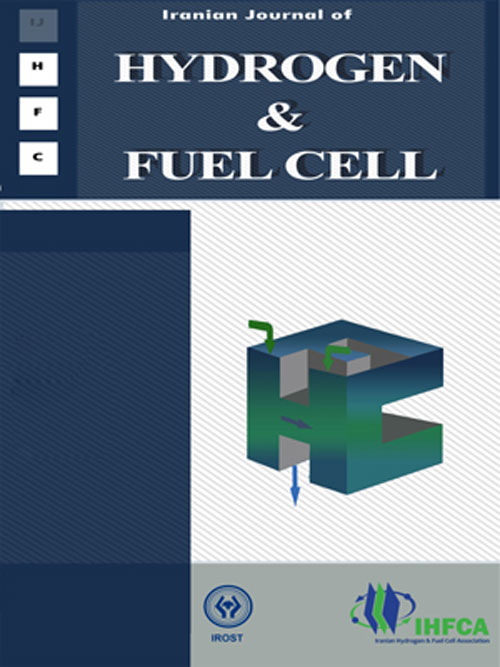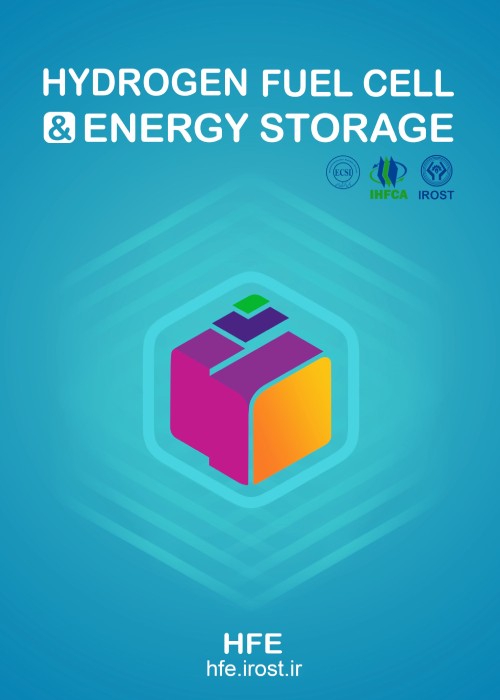فهرست مطالب

Journal of Hydrogen, Fuel Cell and Energy Storage
Volume:2 Issue: 2, Spring 2015
- تاریخ انتشار: 1394/06/30
- تعداد عناوین: 6
-
-
Pages 67-74Palladium nanoparticles supported on multi-walled carbon nanotubes (Pd/MWCNTs) have been synthesized using a modified polyol reduction method and its performance in methanol oxidation reactions has evaluated. The morphology of palladium on MWCNTs was characterized by scanning electron microscopy (SEM) and transmission electron microscopy (TEM). The catalytic performance of synthesized catalyst was examined for methanol oxidation in a N2- saturated solution of 1 M KOH and 1 M CH3OH. Cyclic voltammetry (CV) analysis demonstrate that the Pd/MWCNTs catalyst exhibits lower catalytic activity compared to the commercial Pt/C, but because of its relatively low-cost, the as prepared Pd/MWCNTs might be economically viable alternative for methanol oxidation. The chronoamperometry technique is an effective method to evaluate the electrocatalytic activity and stability of the alcohol oxidation reaction. The chronoamperometry results showed that Pd supported on MWCNT has a better long-term stability in comparison to Pt/C that is related to good dispersion of Pd nanoparticles on the surface of support.Keywords: Palladium nanoparticles, multi, walled carbon nanotubes, methanol oxidation
-
Pages 75-83A micro-channel heat exchanger reactor with different micro-baffle shapes has been studied numerically. Governing equations were solved base on the finite volume method with FLUENT software. In upper section, oxidation reaction of methanol was occurred and in lower section, steam reforming of methanol was done. Two sections were separated with solid part which played as heat exchanger and transferred heat from oxidation reaction to steam reforming section. In addition to, straight micro-channel, some other types with different micro-baffle shapes, both sides of solid section, were studied. Micro-baffles are thought to act as static mixers, induce further mixing and improve the convective heat transfer coefficients which eventually expedite heat transfer, so conversion efficiency increases. Also, hydrogen yield obtained with micro-baffle with rectangular shape is 17% higher, on average, than that obtained with the straight configuration. Five different micro-baffles with Rectangular, Triangular, Triangular 90, Trapezoidal and Trapezoidal 90 shapes were studied and higher conversion efficiency for micro-baffles with Trapezoidal shape was achieved.Keywords: micro, baffle, Steam reforming, micro, channel reactor, numerical modeling
-
Pages 85-97Microbial electrolysis cell (MEC) is one of the promising and cutting-edge technologies for generating hydrogen from wastewater through biodegradation of organic waste by exoelectrogenic microbes. In the MECs, the operational parameters, such as applied voltage (Eap), anode surface area, anode-cathode distance, and N2/CO2 volume ratio have a significant impact on the hydrogen yield and production. In the present study, to enhance current and hydrogen production of MEC, the effects of key operational conditions on the MEC performance were extensively investigated. The optimal operating condition for hydrogen production in MECs was determined as: the optimum applied voltage of 1.1 V, anode surface area of 94 (cm2), anode-cathode distance of 1.5 (cm), and a N2/CO2 volume ratio of 4:1. With these optimum conditions, the maximum H2 volume, current density and hydrogen production rate (HPR) of MEC could be reached to 270.09 mL, 314.01 ± 2.81 A/m3, and 4.25 ± 0.55 m3 H2 /m3 d, respectively. The results obtained in this study imply that a systematic investigation of the key operational variables is an effective strategy to maximize the hydrogen production in single-chamber MECs.Keywords: Microbial electrolysis cell, Applied voltage, Hydrogen, electricity, Geobacter sulfurreducens PCA, Hydrogen production rate
-
Pages 99-107In the current work, graphene oxide (GO) samples were prepared at room temperature from graphite flakes using a modified Hummer's method to produce metal-free electrocatalysts. The effect of the duration of the oxidation process on the structural, chemical and physical characteristics of the GO samples was evaluated using X-ray diffraction (XRD), Fourier transform infrared spectroscopy (FTIR), ion-exchange capacity (IEC) measurements and Field-emission scanning electron microscopy (FESEM). Electrochemical behavior of the GO samples towards hydrogen adsorption/reduction (HAR) reactions was evaluated using a typical three-electrode electrochemical cell at room temperature under N2 atmosphere. Increasing the oxidation time from 3 h to 5 h resulted in dramatic decreases in the number of epoxy and carboxyl groups, interlayer spacing (~ 9.5%) and also in the IEC (~ 1.8 times) of the GO samples. Moreover, increasing the oxidation time resulted in a remarkable increase in the size of the GO sheets along two dimensions (~ 1.5 times) and also in electrochemical surface area (ECSA) of GO (~60%). CV studies revealed that increasing the oxidation time results in an increase in the current response of GO samples towards HAR reaction, indicating an enhancement in the electrochemical activity of GO. This was attributed to the formation of larger GO samples with improved electronic network.Keywords: Graphene oxide, HAR reaction, Proton exchange membrane fuel cell
-
Pages 109-119Core-shell nanostructures are emerging as more important materials than alloy nanostructures and have much more interesting potential applications in various fields. In this work, we demonstrated the fast and facile synthesis of core-shell nanoparticles consisting of Pt thin layer as the shell and Ni nanoparticles as the cores. The described method herein is suitable for large-scale and low-cost production of the core-shell nanoparticles. X-ray diffraction, scanning electron microscopy, transmission electron microscopy and energy dispersive X-ray spectroscopy techniques were used to investigate the physicochemical characterizations. Importantly, the catalytic activity of Ni@Pt core-shell nanoparticles was probed to develop electrocatalyst in direct ethanol fuel cells (DEFCs). This electrocatalyst was applied to ethanol oxidation reaction for first time. Thus, the electrocatalytic activity of the Ni@Pt core-shell nanoparticles towards ethanol oxidation reaction has been investigated by cyclic voltammetry and chronoamperometry methods in NaOH solution. The Ni@Pt core-shell nanoparticles show markedly enhanced electrocatalytic activity and stability for ethanol oxidation compared with the Pt nanoparticles catalyst. The results indicate that the Jf/Jb of Ni@Pt is 1.4 times that of Pt. This high electrocatalytic performance can be attributed to the unique structure of the as-prepared nanoparticles. The attractive performances of Ni@Pt core-shell nanoparticles make them a promising candidate electrocatalyst for ethanol electrooxidation.Keywords: Ni@Pt nanoparticles, Core, shell, Electrooxidation, Ethanol, Alkaline media
-
Pages 121-130In this study PtFeCo ternary alloys nanoparticles of three dimentional (3D) rhombus shapes dispersed on graphene nanosheets (PtFeCo/Gr) were successfully prepared and studied as electrocatalysts for oxygen reduction reaction (ORR) in polymer-electrolyte fuel cells. A combination of analytical techniques including powder X-ray diffraction, X-ray photoelectron spectra, inductively coupled plasma-atomic emission spectrometry, scanning electron microscopy and electrochemical methods have been used for characterization of the synthesized electrocatalysts in this study. For comparison, the graphene supported PtFe catalyst (PtFe/Gr), graphene supported PtCo catalyst (PtCo/Gr) binary alloys and graphene supported Pt catalyst (Pt/Gr) were also synthesized and investigated under the same experimental conditions. From the electrochemical analysis, it is found that PtFeCo/Gr particles exhibited an obvious enhancement of ORR activity in comparison with pure Pt and binary alloys. The significantly improved EAS, ORR activity and cell performance is achieved by increasing the utilization of PtCoFe/Gr electrocatalyst by increasing the three-phase boundary in the electrocatalyst layer.Keywords: Graphene, PtFeCo alloy, 3D rhombus shapes, Oxygen reduction reaction


